I remember sitting in a college calculus class and one of the students asked, "When are we ever going to use this in real life?"
The professor gave an answer that I wished some of my junior high and high school math teachers would have said when I was learning algebra and trigonometry, "Chances are, you're never going to use this in your daily life. This level of math isn't so much about using it in 'real life.' It is more about being persistent and disciplined, and finding the answer to a problem."
Math comes down to simple problem solving; and training one's brain to be able to think through a variety of situations and get to the right answer or come to a conclusion. Math, to me, means essentially fostering a sense of determination and commitment to finish something you've started.
Because math goes beyond just learning numbers, functions, and concepts, I try to give Sophia and Olivia opportunities to learn math through a variety of methods: traditional/book learning, singing, learning tools, games, and real-life application.
TRADITIONAL/BOOK LEARNING
The girls learn core math concepts and facts by using their math books. I use Rod & Staff books since both girls say they like them. At the last homeschool conference I attended, I looked at a variety of math books. Some had a lot of color and impressive graphic design; some used the computer; and others used DVDs to teach math. After looking at the variety of resources, I decided to stick with Rod & Staff.
Rod & Staff isn't fancy - the text and images are all in black and white. However, the majority of examples they use all tie into agriculture, farm animals, and cooking/baking - all things that are quite applicable to the girls' life right now.
Sophia's fourth grade math book.
There seems to be a lot of repetition with some of the fundamental concepts and facts (e.g., addition and subtraction facts, skip counting by 2s/5s/10s, multiplication and division facts). However, knowing these facts by memory is critical to forthcoming math skills, so I think that's valuable.
That being said, once the girls have "mastered" a skill, I don't make them continue doing pages of the same thing. They can move onto the next skill. That's one of the benefits of homeschooling - adapting the lessons to the each child's skills and knowledge.
Olivia likes to use manipulatives to help her visualize
some of the math problems she's doing.
For this lesson, she chose to use shells.
The girls both enjoying singing and seem to retain information much better when they learn it by listening to and singing songs.
Some of the CDs that the girls use for math.
- Shiller Math Songs - this was a CD that Olivia used a couple of years ago when using the Shiller math curriculum. There are a variety of songs that had her moving about while listening to instructions on the CD.
- Addition Songs by Kathy Troxel - this CD comes with a songbook/workbook, and has helped Olivia learn counting from 1 to 20 as well as all the addition facts from 1+1 to 9+9. There are sing-along songs as well as echo-style songs for self-testing.
- Multiplication Songs by Kathy Troxel - this CD also comes with a songbook/workbook, and has helped Sophia learn all the multiplication tables 2 through 12. There are sing-along songs as well as echo-style songs for self-testing.
- One Hundred Sheep by Roger Nichols - There are nine songs on this CD that teach counting by 2s, 3s, 4s, 5s, etc. This skill is known as "skip counting" and is used in every math process from multiplication to algebra. The songs use stories from the Gospels as a basis for the lyrics. Both the girls use this CD.
Sophia singing along with the
One Hundred Sheep CD.
LEARNING TOOLS
Dice
Olivia playing with some of the math dice.
One of the ways to learn and/or review the basic facts is by using dice.
Basic math equation that Olivia put together
using three different types of dice.
- Blue dice with the numbers 1-6 on them.
- Green dice with the numbers 7-12 on them.
- White dice with different symbols (e.g., plus, minus, times, divided by).
- Yellow dice with Roman numbers.
- Big red and orange dice with little white dice inside it. Both the dice have the traditional 1-6 dots on each side.
A variety of dice to use with math games.
Electronic Flash Cards
Learning Resources has a Minute Math Electronic Flash Cards in which the girls are presented with different facts (e.g., 2+9, 8x7) and need to type in the answer. The "game" is based on speed and accuracy. There is a voice that tells the player if she typed in the correct answer.
Sophia testing herself on multiplication facts.
Sophia likes this "game," but Olivia finds it frustrating. So, when Sophia needs/wants to do something different for math, she'll use the Electronic Flash Cards.
Learning Wrap-Ups
Both the girls learn best when there is a hands-on component to the lesson. One of the things that I found at the last homeschool conference was a set of Learning Wrap-Ups. Each Wrap-Up focuses on a different process (e.g., addition, subtraction, multiplication, division).
Olivia testing herself on addition facts.
To use them, the girls start with the first number on the left side and add/multiply it by the number in the middle of the key. Then they find the answer on the right hand side and bring the yarn to the other side and wrap it around the backside before bringing it to the second number on the left side. They repeat the process until all the numbers and answers have been wrapped.
Olivia with the finished Wrap-Up.
The string was where it should be on the back,
so she got all the answers correct.
The Wrap-Up is self-checking on the back. The key has a raised pattern to show where the yarn should be. If the yarn matches the pattern, then all of the answers were done correctly.
GAMES
The girls have many games that they enjoy playing that have a math component to them: Horse-opoly, Life, and Farm-opoly.
The girls playing Farm-opoly.
In addition to purchased games, we've also made our own math games. For Thanksgiving, we made a turkey racing game (see below) that involved counting and probability. The girls had fun making and playing the game, and having it be a part of Thanksgiving activities in the future.
Homemade math game.
REAL LIFE APPLICATION
Bringing math into everyday activities provides the girls with a learning experience in a real-life setting, and helps enhance comprehension of what they are learning.
Sophia learning to skip count
by 5s and 10s using buttons.
An early math skill is sorting, although it is one that people use in their daily lives. One of the ways that sorting was incorporated into homeschooling is through stamp collecting. The girls each have their own books for stamps, and have enjoyed sorting them into categories (e.g., horses, flowers, pandas, wild animals).
Olivia sorting through stamps when she was very young.
She still has and adds to her stamp collection.
Another way that the girls have used math is when they have sorted items to donate. Each year we do Operation Christmas Child. The girls enjoy choosing items to put in the boxes, and then dividing and sorting them at home.
The girls sorting items for Operation Christmas Child boxes.
Olivia with candy she sorted.
Math also is used when studying science.
Sophia measuring the length of a bone.
Sophia measuring the snow depth.
Sophia measuring and adding an ingredient
to make a fruit smoothie.
I've had a food scale for many years, and it seems like in the past few years that it has been used more frequently by the girls - whether they are making food in the kitchen or weighing an item for a science lesson.
The girls were weighing some mushrooms they found
on the nature trail.
The girls are cutting and measuring rhubarb
to make dessert.
Money is something that the girls have enjoyed learning about in math. Rather than just using pictures in math books, the girls receive a bit of money for doing some chores. They also receive money periodically as gifts from grandparents and relatives.
Originally, I had the girls set up save-spend-give jars and a percentage of each amount they earned or was gifted was divided into the three jars in a 50-40-10 percent ratio (respectively). Now, I have them do a 50-50 split - save half/spend half. Of the spending money, some they use as donation money.
The girls have their own wallets with money and gift cards, and have learned to interact with cashiers; and vendors at craft shows and farmer's markets. They have to learn to use only the money they have available (no loans or borrowing money). This has taught them the value of budgeting and patience (especially if they need to save for a larger item). I'm hoping that they carry this into their adult life and save half of what they earn.

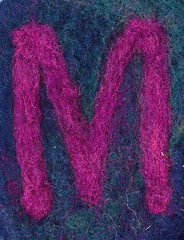


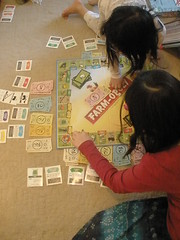
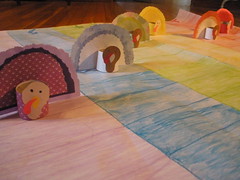
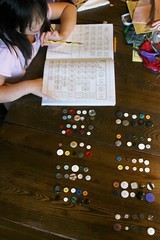
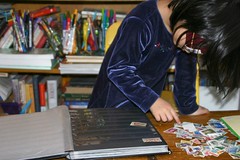
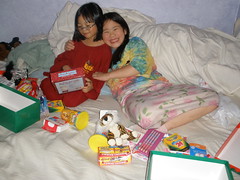
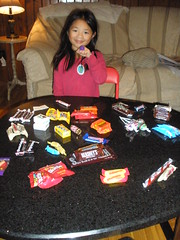
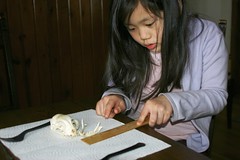

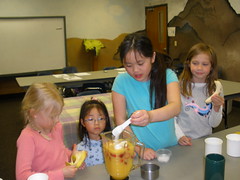
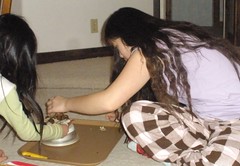

5 comments:
Wow -- so many great math resources here! I'm bookmarking it for ideas. We love the math wrap-ups here, too!
We like math wrap-ups, too. :)
And, once again, your post is full of treasures. Great ideas!
-Heidi
You always have the best ideas!
Great word and great examples. Math is definitely a core in homeschooling. It is always nice to see more ideas on how to make it more fun and interesting. We love games around here.
SO many way to integrate math throughout the day! Sure we may not use higher math but basic math is all around us. Our kids would never even realize it if we didn't start pointing it out.
My oldest really dislikes math until we start pointing out everywhere she uses it on a regular basis (like sewing for instance.) Then she gets this look on her face like, "Well RATS. Guess I have to learn this math stuff after all." ;0)
Good pictures, too, by the way!
Post a Comment